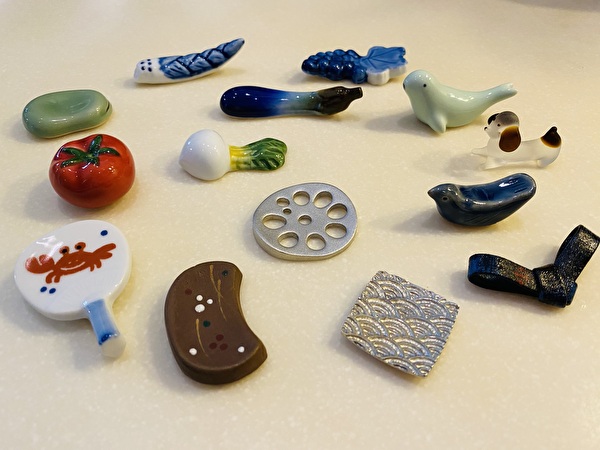「箸置き」
Do you know about Japanese chopstick rests? They have a long history and make our dining table more enjoyable! At 4T-AMKY, Teachers and Students write about Japanese culture, food, history, many spots to visit, and other stuff. Enjoy reading and knowing about deeper Japanese culture!
Chopstick rests.
Joy
Whenever I begin to prepare a meal, my heart is filled with excitement from the moment I decide on which chopstick rests to use. I choose the chopstick rests according to the season or the cuisine.

Last summer, I often enjoyed the fur seal and the crab chopstick rests.

Last autumn, I enjoyed lotus root chopstick rest made of tin.

Now in early spring, I enjoy using my cherry blossom shaped chopstick rest.
When I see a pretty chopstick rest during a meal, it lifts my spirit.

Origin

The origin of chopstick rests is said to be the ear-shaped earthenware called mimi-kawarake, which was used in ancient times when giving offerings to the deities at shrines. It was a special item used in Shinto rituals.
Sourse of photo: Niigata Prefecture Archaeological Research organization from Collection of National Diet Library
Then, chopstick rests became widespread among ordinary people since the Meiji era (1868-1912) when tables were introduced and people began to eat at the table.

Until then, people in Japan had eaten a meal set on a small table called zen on a one-by-one basis sitting on the floor since ancient times and put the dirty tips of chopsticks on a corner of zen, so it seems that there was no need to use chopstick rests.

Now, I’m already wondering which chopstick rest I should use for dinner tonight!
「箸置き」
楽しみ
食事の準備をするたびに心がときめくのは、箸置きを決める瞬間です。
季節や料理にあわせて選びます。
去年の夏は、オットセイやカニを、秋には、錫(すず)製のレンコンを楽しみました。
春になり、今は桜の花を使っています。
食事中も、可愛いらしい箸置きを見ると、ぱっと気持ちがあがります。
*箸置きの起源は、古代から神社で神々にお供え物を捧げる際に用いられた耳土器(みみかわらけ)と呼ばれる耳の形に似た土器だそうです。神事で使う特別なものでした。
**一般庶民が広く使うようになったのは、明治時代以降、ちゃぶ台やテーブルが登場し、大きな食卓でみなが食事をするようになってからだそうです。
それまでは、日本は古来から一人ずつ膳に載せて食べるスタイルが確立していて、汚れた箸先は膳の端に載せて使用していて、膳自体が箸置きの役割を持っていたので、箸置きは必要なかったようです。
さて、今夜の夕食はどの箸置きにしようかな。
参考資料:*「フリー百科事典ウィキペディア」
**オーダーメイド ガラス・ドアの専門店 D+kuru(ディークル)「箸置きの存在意義」:https://www.d-kuru.com/diary-detail/685
耳土器の写真:[新潟県埋蔵文化財調査事業団] 国立国会図書館蔵より
Aki. S.






